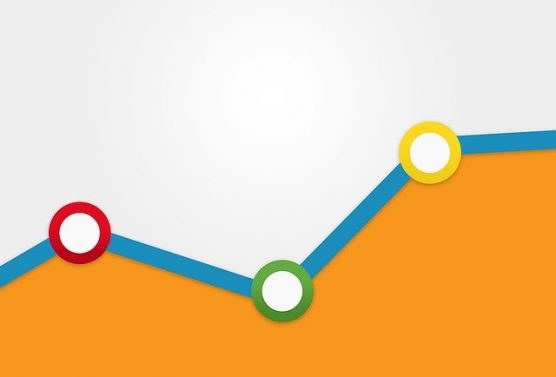
You may think of your website as merely a way to be found on the Web. Perhaps, you see it as just another way of improving your business. Each of these thoughts is correct. However, in order for your website, and by extension your business, to be found and your revenue improves then you need to have more than just a website – you need to have a marketing plan that leverages your website to transform into conversions, or actionable items such as signing up for your newsletter, filling out a contact form or purchasing something from your store.
You need to use Google Analytics to track goal conversions. Really. If you are unfamiliar with Google Analytics then it could be helpful to understand what it is. Google Analytics is a popular tool that is currently used by 66% of all websites. It works by tracking a website’s data and then showing it in detailed tables, charts, and graphics. Each of these elements comprises an assortment of information. And it’s free.
Making the Most of Google Analytics

- Real-Time – This shows how your site guests are interacting with your website in real-time. This will let you know where your leads are coming from, what they looked at, and at what point they left your website.
- Behavior – See how people navigate your site, where they pause, how long they spent on the various pages, bounce rates, and much more.
- Audience – Find out your site guests’ demographics, what pieces of your content interests them, and what type of device(s) they use to access your site.
- Acquisition – This allows you to track where your site traffic is coming from, how they are reaching your site, and how each source is behaving on your website.
These reports and others like them are all ways that you can use Google Analytics to reach your goals for your website. What makes the Google Analytics tool so great is that when you set up your account you can also set up goals specific to your website and needs.
How to Set Up Goals in Google Analytics
Setting goals in Google Analytics can be done for any website. It is just a matter of knowing how to create goals that will serve you and your website well. You can choose to configure your goals using either a template or a custom goal. So how do you set up goals in Google Analytics? Let’s get started.
- Sign in to your Google Analytics account and choose the website that you will be creating a goal for.
- Click Admin and in the View column, select Goals.
- Click the New Goal Button
- You can now set your goal, a description of the goal, and add a name for the goal. It is suggested by Google that you opt for goal names that you need to select an intuitive name.
- Enter the goal type.
Sounds simple, right?
…. and to some degree, it might be. Yet there is a bit more to it than simply filling in the blanks. You need to select the best type of goal to achieve your purpose(s). Custom goals for Google Analytics will be one of these four types:
- Destination – When a specific location loads; this type of goal is set up to follow the path your users follow to reach a specific destination. With Destination goals, one works with a path referred to as a funnel in which you specify the steps of the funnel and allows you to track where users enter and exit the track to your specific goal.
- Duration – How long a site guests’ visit lasts; you can specify the minimum amount of time that meets a specific goal so that when a user stays on a page longer than the minimum it is counted as a conversion.
- Pages/Screens per Session – The specific number of pages or screens a user views; users who look at more than the set number of pages or screens counts as a conversion.
- Event – An action a user takes, whether it be on your website or app.
How to Get Goal Conversions

But there are actions you can take to improve your website’s conversion rates and thus improve your revenue. Here are a few to get you started.
- Add a pop-up menu- Web/app developers, Sumo, did a study and found out that the average conversion rate for pop-ups is 3.09%. Your pop-up might be a different product, a PDF, or perhaps a free product, but whatever it is you need it to be something that gets your guests’ attention but doesn’t annoy them. Consequently, be sure the pop-up lasts no more than 30 seconds or is easy to close out of.
- Add testimonials, reviews, and logos – This helps build trust and encourage a site guest to connect and helps them to feel at ease. In fact, one growth expert found that adding social proofs can increase conversion rates by as much as 400%.
- Make it easy – Don’t have a dozen blanks on a form to be filled in. Make it simple, say just an email address. People don’t like to provide information until they are ready to make a commitment, and they are less likely to want to commit if they aren’t being asked a litany of information gathering questions.
- Have a strong Call to Action (CTA) – Think about what you want to say. A button saying “buy now” is not as effective as one that says “Yes, get my discount” or “Yes, I want to save money”.
- Have a money-back guarantee – If you have an e-commerce site then it is important that guests know that they can get their money back if they are unsatisfied. Yes, you might need to protect yourself with a disclaimer on some types of products/services but the money-back guarantee lets people feel more in control.
- Add a point of purchase upsell – This won’t actually change your conversion rates, but it is a way to improve your revenue. Just before a guest finishes their purchase, offer a sale or promo on a similar product that is easily added to their order. This can increase revenue by 10-20%.
- A/B testing – No matter how long you spend crafting the wording for your site, there is often a better way or different approach to use to increase site conversions. Do this with A/B testing of your website’s headings. It may mean incorporating statistics (or not), more or less use of numbers, the words used, or even the color or design of the page. But you won’t know without doing a couple of trials and determining which is most effective.
- Implement Live Chat – This is a great way to build trust and make it easier for site guests to get the information they are looking for. Even better, it will add to the amount of time a person is on your site and thus increase your conversion rate.
And there you have it. A simple approach to getting Google Analytics and goals in place. And, to help you go a step further, a few tips for making the most out of your goal-setting efforts.
But all of the above stated, there are some things that can’t be done when setting goals through Google. Here are a few of them (for more, be sure to check out Google’s site).
- When viewing your goals, you are limited to 20 per reporting view. You can see more than 20 by designing an additional view for that property or by editing a goal you no longer need.
- While a goal cannot be removed, you can choose to stop recording info about that goal.
- Goal data is processed differently than Google Analytics data.
Setting Google Analytics goals and then optimizing your website to help you reach these goals is an important part of making your business prosperous. But, it can seem a bit daunting to get everything in place. Thankfully, you don’t have to be a Google pro and have the answers and know-how to do it alone. Page Progressive has a team that understands how important your business is, and will work with you to help you set up your Goggle Analytics and goals for success. Give us a call today.